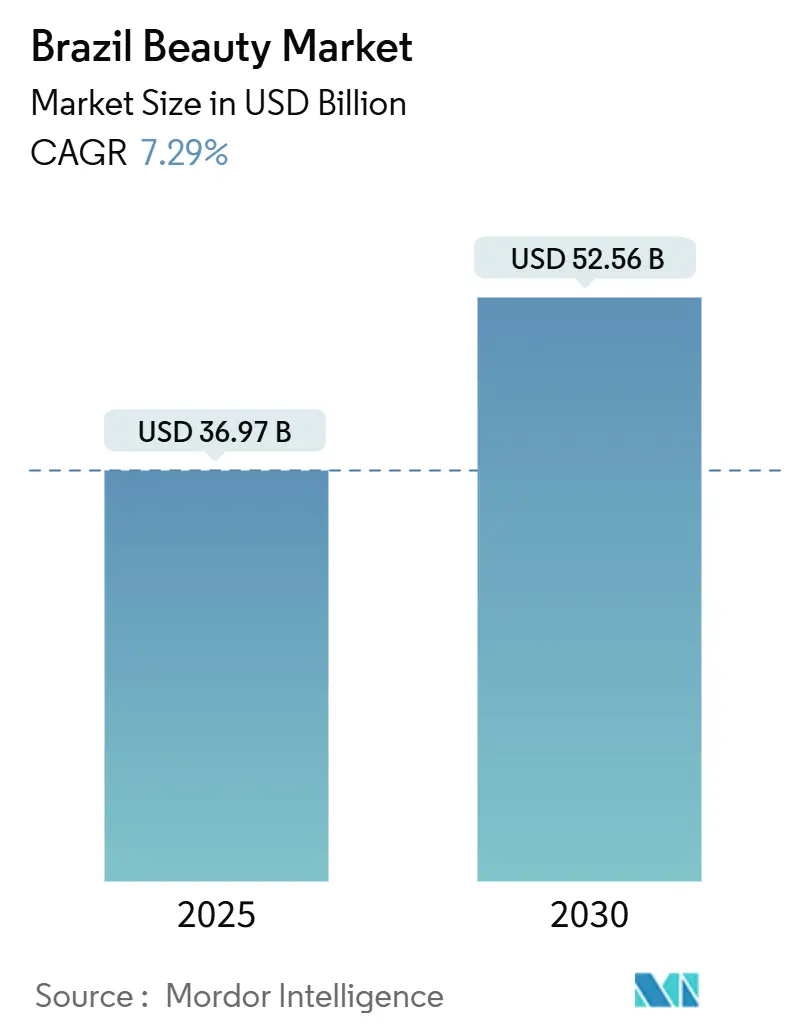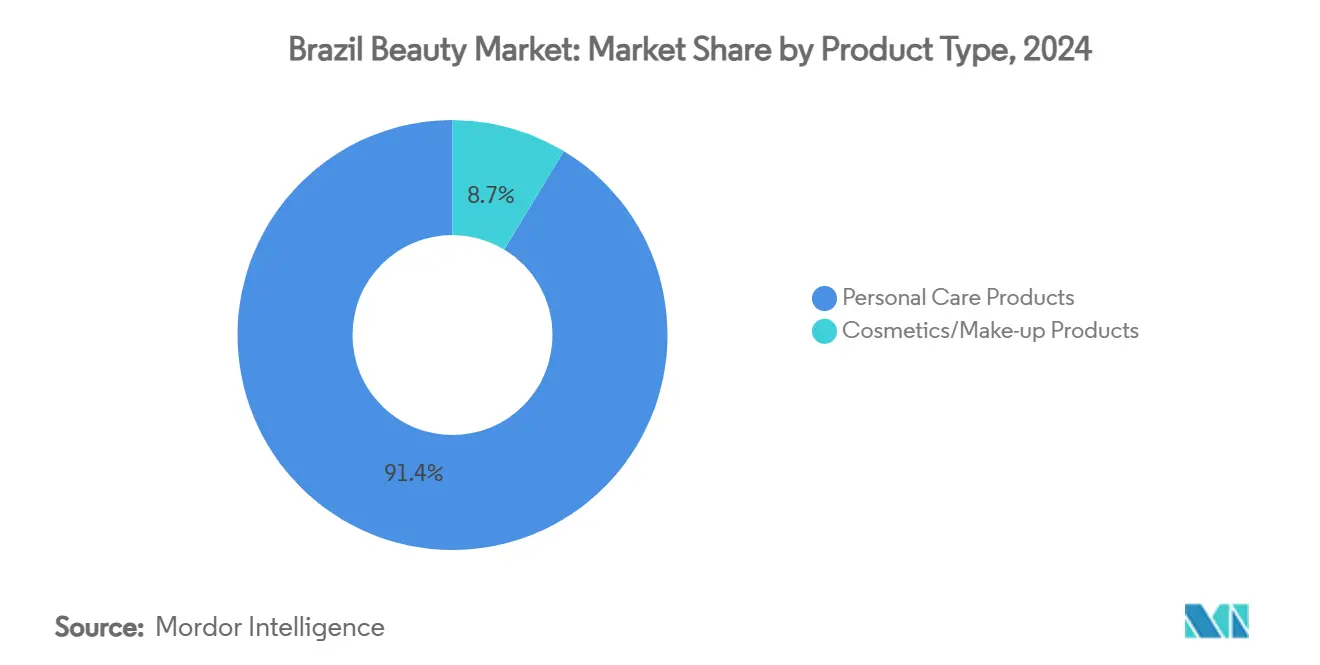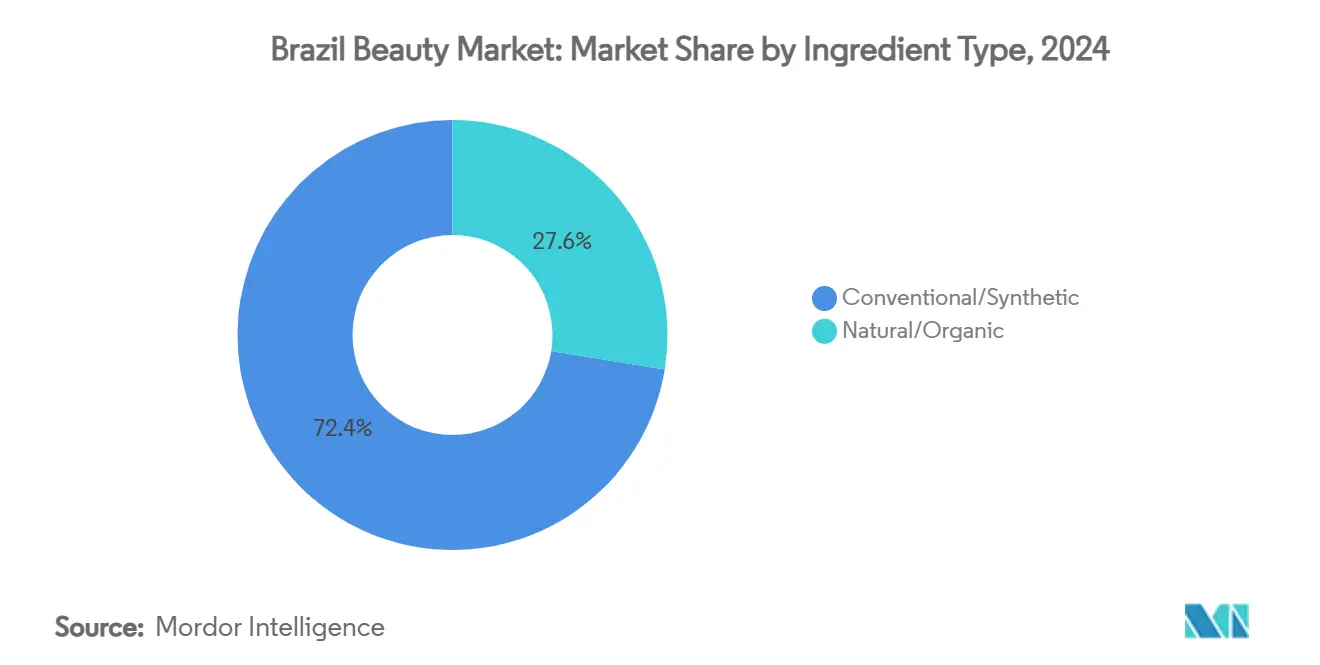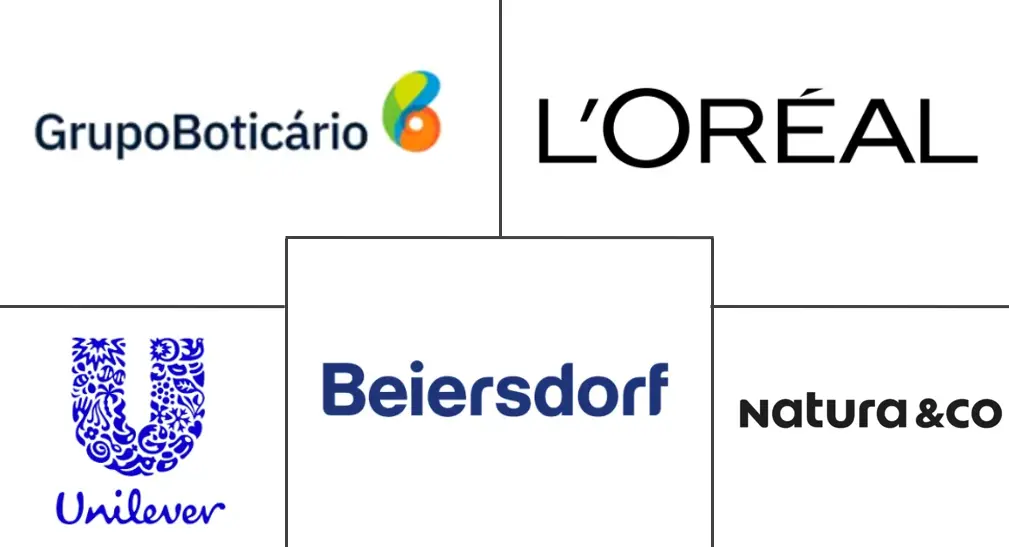
Brazil Beauty Market Analysis by Mordor Intelligence
The Brazilian beauty market size is expected to grow from USD 36.97 billion in 2025 to USD 52.56 billion by 2030, at a CAGR of 7.29% during the forecast period (2025-2030). The market's growth is driven by increasing consumer awareness regarding personal grooming, rising disposable incomes, and the growing influence of social media and beauty trends. Brazil, being one of the largest markets for beauty and personal care products in South America, benefits from a diverse consumer base and a strong preference for innovative and high-quality products. Additionally, the demand for natural and organic products is gaining traction, further fueling market expansion. The presence of both global and domestic players intensifies competition, leading to continuous product innovation and strategic marketing initiatives.
Key Report Takeaways
- By product type, personal care products held a 91.35% share of the Brazil beauty market in 2024 and are projected to grow at a CAGR of 7.48% through 2030.
- By category, mass products commanded a 92.43% share of the Brazil beauty market size in 2024, while premium lines are expected to grow at a 7.89% CAGR through 2030.
- By ingredient type, conventional/synthetic formulations maintained a 72.43% share in 2024, while natural/organic formulations are projected to grow at an 8.12% CAGR.
- By distribution channel, specialty stores accounted for 38.58% of revenue share in 2024, while online retail stores represent the fastest-growing distribution channel with an 8.77% CAGR through 2030.
Brazil Beauty Market Trends and Insights
Drivers Impact Analysis
| Driver | (~) % Impact on CAGR Forecast | Geographic Relevance | Impact Timeline |
|---|---|---|---|
| Growing demand for anti-aging and sun protection products | +1.2% | National, with higher concentration in Northeast and Southeast regions | Medium term (2-4 years) |
| Growing consumer awareness about personal grooming and hygiene | +0.9% | National, with urban areas leading adoption | Long term (≥ 4 years) |
| Influence of social media and impact of digital technology on the market | +1.5% | National, with stronger impact in metropolitan areas | Short term (≤ 2 years) |
| Rising popularity for sustainable and natural ingredients | +1.1% | National, with premium segments in São Paulo and Rio leading | Medium term (2-4 years) |
| Product innovation in formulations and packaging | +0.8% | National, with R&D centers concentrated in Southeast | Medium term (2-4 years) |
| Increased focus on oral hygiene | +0.6% | National, with rural areas showing accelerated adoption | Long term (≥ 4 years) |
| Source: Mordor Intelligence | |||
Growing demand for anti-aging and sun protection products
The growing demand for anti-aging and sun protection products is a significant driver in the Brazil beauty market. Consumers in Brazil are increasingly prioritizing skincare solutions that address aging concerns and protect against harmful UV rays, driven by heightened awareness of skin health and the effects of prolonged sun exposure. For instance, products containing ingredients like hyaluronic acid, retinol, and antioxidants are gaining traction due to their effectiveness in reducing wrinkles and fine lines. Similarly, sunscreens with high SPF levels and broad-spectrum protection are witnessing increased adoption, especially in regions with intense sunlight. The rise of multifunctional products, such as moisturizers with SPF and anti-aging properties, further supports this trend. According to Associação Brasileira da Indústria de Higiene Pessoal, Perfumaria e Cosméticos, the import value of beauty and personal care products in Brazil reached over USD 170 million, highlighting the growing consumer demand for these products [1]Source: Associação Brasileira da Indústria de Higiene Pessoal, Perfumaria e Cosméticos, “Comércio Exterior Balança Comercial Setor de HPPC Dezembro/2023”, abihpec.org.br. Additionally, the influence of social media and beauty influencers has amplified consumer interest in premium and innovative skincare solutions, contributing to the growth of this segment within the market.
Growing consumer awareness about personal grooming and hygiene
In Brazil, consumers are placing a heightened emphasis on personal grooming and hygiene, propelling the growth of the beauty and personal care products market. This shift is largely attributed to a growing awareness of self-care and the significance of a polished appearance. For example, as consumers become more attuned to safeguarding their skin from environmental harm, there's been a notable uptick in the demand for skincare items like moisturizers and sunscreens. Likewise, as individuals prioritize hair health, the market for hair care products, such as shampoos and conditioners, is witnessing expansion. The rising popularity of grooming essentials, including razors, trimmers, and deodorants, underscores the heightened focus on personal hygiene among Brazilians. Additionally, the sway of social media and beauty influencers has magnified the spotlight on grooming routines and hygiene, nudging consumers towards investing in premium personal care items. Data from ITC Trade Map reveals a significant surge in Brazil's import value of shaving preparations, jumping from USD 49,846 Thousand in 2022 to USD 87,676 thousand, underscoring the escalating demand [2]Source: ITC Trade Map, Import Value of Shaving Preparations (HS Code: 3307), trademap.org. Bolstering this growth is Brazil's rising disposable income, allowing consumers to splurge on upscale beauty and personal care items. Collectively, these dynamics are poised to sustain the market's momentum in the coming years.
Influence of social media and impact of digital technology on the market
Social media and digital technology are significant drivers of the Brazil beauty market. The increasing penetration of social media platforms, such as Instagram, Facebook, and TikTok along with rising internet users, has transformed how consumers discover and purchase beauty products. According to a report by the Centro Regional de Estudos para o Desenvolvimento da Sociedade da Informação, in 2023 over 84% of Brazilians actively use the internet [3]Source: Centro Regional de Estudos para o Desenvolvimento da Sociedade da Informação, "Meaningful connectivity and digital skills," cetic.br. Furthermore, data from the Brazilian Institute of Geography and Statistics (IBGE) highlights that social media usage is particularly high among younger demographics, who are key consumers of beauty and personal care products. This trend has encouraged brands to invest heavily in digital marketing strategies, influencer collaborations, and online campaigns to reach their target audience effectively. Additionally, advancements in digital technology, including augmented reality (AR) tools for virtual try-ons, have enhanced the consumer shopping experience, further driving market growth. The integration of e-commerce platforms with social media has also streamlined the purchasing process, making it easier for consumers to access a wide range of beauty and personal care products.
Rising popularity for sustainable and natural ingredients
The Brazil beauty and personal care product market is witnessing a significant rise in demand for sustainable and natural ingredients. Consumers are increasingly prioritizing products that align with eco-friendly practices and contain organic components. This shift is driven by growing environmental awareness and a preference for healthier lifestyle choices. Manufacturers are responding by incorporating plant-based, biodegradable, and ethically sourced ingredients into their product formulations. Additionally, regulatory bodies in Brazil are encouraging the use of sustainable materials, further propelling this trend. The emphasis on transparency and clean labeling is also influencing purchasing decisions, as consumers seek products that clearly communicate their natural and sustainable attributes. This growing inclination toward eco-friendly and organic ingredients is expected to play a pivotal role in shaping the market during the forecast period.
Restraints Impact Analysis
| Restraint | (~) % Impact on CAGR Forecast | Geographic Relevance | Impact Timeline |
|---|---|---|---|
| Counterfeit and grey market cosmetics undermining brand trust | -0.8% | National, with higher concentration in Northeast and North regions | Short term (≤ 2 years) |
| Complex regulatory framework for organic and vegan certifications | -0.5% | National, affecting premium and natural product segments | Medium term (2-4 years) |
| Price sensititivy among consumers | -1.2% | National, with stronger impact in lower-income regions | Short term (≤ 2 years) |
| High manufacturing costs for premium and natural products | -0.7% | National, with manufacturing concentrated in Southeast | Medium term (2-4 years) |
| Source: Mordor Intelligence | |||
Counterfeit and grey market cosmetics undermining brand trust
The prevalence of counterfeit and grey market cosmetics poses a significant restraint on the growth of the Brazil beauty market. Counterfeit products, often sold at lower prices, not only undermine the revenue of legitimate brands but also compromise consumer safety due to the use of unregulated and potentially harmful ingredients. These counterfeit items often mimic the packaging and branding of genuine products, making it difficult for consumers to differentiate between authentic and fake goods. This leads to dissatisfaction among consumers when the counterfeit products fail to meet quality expectations, further damaging the reputation of established brands. Additionally, grey market cosmetics, which are genuine products sold through unauthorized channels, dilute brand exclusivity and disrupt pricing strategies. These unauthorized sales channels often bypass official distribution networks, leading to inconsistencies in product availability and pricing. This not only creates confusion among consumers but also weakens the control that brands have over their supply chain and market positioning. The increasing availability of counterfeit and grey market products, both online and offline, further exacerbates the problem.
Complex regulatory framework for organic and vegan certifications
The complex regulatory framework for organic and vegan certifications poses a significant restraint in the Brazil beauty market. Companies face challenges in adhering to stringent certification standards, which vary across regions and governing bodies. These regulations often require extensive documentation, rigorous testing, and compliance with specific ingredient sourcing and production processes. Additionally, the high costs and time-consuming nature of obtaining certifications can deter smaller players from entering the market. The lack of uniformity in certification criteria further complicates the process, creating barriers for manufacturers aiming to position their products as organic or vegan. This regulatory complexity impacts the growth potential of the market, as companies must allocate substantial resources to meet these requirements, potentially delaying product launches and increasing operational costs. Furthermore, the evolving nature of these regulations adds another layer of difficulty, as companies must continuously adapt to new standards to maintain compliance. This dynamic environment creates uncertainty for manufacturers, making long-term planning and investment decisions more challenging.
Segment Analysis
By Product Type: Personal Care Drives Scale While Cosmetics Accelerate
In 2024, personal care products dominate the Brazil beauty market with a commanding 91.35% market share and are projected to grow at a robust 7.48% CAGR through 2030, outpacing the broader market. Within this leading segment, hair and skin care products are gaining significant traction, driven largely by Brazil's climate-specific demands. The facial care segment, in particular, is experiencing rapid growth within skin care, as Brazilian consumers increasingly adopt multi-step routines inspired by global beauty trends. This shift reflects a growing awareness of advanced skincare practices and a preference for premium products tailored to individual needs.
Bath and shower products in Brazil are evolving beyond their traditional role of basic cleansing. These products now integrate aromatherapy and wellness features, catering to the rising consumer emphasis on self-care and holistic well-being. The incorporation of such features highlights a shift in consumer preferences toward products that offer both functional and experiential benefits. This trend aligns with the broader movement in the market, where consumers seek products that enhance their overall lifestyle while addressing specific personal care needs.

By Category: Mass Market Evolves with Value-Added Propositions
In 2024, mass products hold a dominant 92.43% share of Brazil's beauty market, highlighting the nation's socioeconomic landscape and the sector's ability to offer beauty solutions that appeal to a broad consumer base. Brazil's demographic makeup, where many remain budget-conscious despite growing purchasing power, drives this dominance. The mass market strengthens its position by adapting quickly; brands now incorporate advanced ingredients and technologies, once exclusive to premium products, into their offerings. This shift has created a "masstige" segment, delivering enhanced value without premium pricing.
Brazil's premium beauty market is expected to grow at a CAGR of 7.89% through 2030. This growth is driven by increasing consumer demand for high-quality, innovative, and luxury products. Factors such as rising disposable incomes, urbanization, and a growing preference for premium brands among Brazilian consumers are contributing to this upward trend. Additionally, the segment benefits from advancements in product formulations, packaging, and marketing strategies that appeal to the evolving preferences of the target audience. The premium category's expansion reflects a shift in consumer behavior, emphasizing quality and brand value over cost considerations.
By Ingredient Type: Conventional Formulations Maintain Dominance
Conventional/synthetic ingredients command a dominant 72.43% share of the market in 2024. Their stronghold is bolstered by established manufacturing infrastructures, cost advantages, and a track record of efficacy across a range of product applications. This dominance is especially evident in mass-market products, where price sensitivity drives the need for cost-effective, scalable formulation strategies. Continuous innovations in synthetic ingredient technology further fortify this sector. Notable advancements, such as silicone derivatives, synthetic polymers, and lab-created actives, are enhancing performance characteristics to cater to specific consumer demands.
The natural/organic segment is expected to grow at a CAGR of 8.12% through 2030. This growth is driven by increasing consumer awareness regarding the benefits of natural and organic ingredients, coupled with a rising preference for sustainable and eco-friendly products. The segment's expansion is further supported by the growing availability of such products across various distribution channels, including e-commerce platforms and specialty stores. Additionally, the demand for clean-label products, free from harmful chemicals, is fueling the adoption of natural and organic offerings in Brazil's beauty market.

By Distribution Channel: Specialty Stores Lead While E-commerce Surges
Specialty stores held a dominant 38.58% share in 2024, highlighting their strong presence in the retail landscape. These stores cater to a wide range of consumer preferences by offering curated product selections, personalized services, and exclusive brands. Their ability to provide a tailored shopping experience has solidified their position as a preferred channel for beauty and personal care products in the country. Additionally, specialty stores often benefit from customer loyalty programs and in-store promotions, which further enhance their appeal. The physical presence of these stores allows consumers to test and experience products before purchasing, a factor that continues to drive their popularity despite the growing competition from online channels.
Meanwhile, online retail stores are emerging as the fastest-growing distribution channel in Brazil, with a projected CAGR of 8.77% during the 2025-2030 period. The rapid growth of e-commerce is driven by increasing internet penetration, the convenience of online shopping, and the availability of a diverse range of products. Consumers are increasingly drawn to online platforms due to their ability to compare prices, access customer reviews, and explore a broader selection of brands and products. Additionally, the adoption of digital payment methods, frequent promotional offers, and the rise of mobile commerce are further fueling the expansion of online retail in the beauty and personal care segment.
Geography Analysis
Brazil's beauty and personal care market benefits from the country's position as South America's largest economy and most populous nation. The Southeast region, anchored by São Paulo and Rio de Janeiro, drives premium product adoption and serves as the primary market for international brands entering Brazil. These metropolitan areas demonstrate higher disposable incomes and beauty sophistication, making them ideal testing grounds for new product launches and premium positioning strategies.
The Northeast region shows strong growth potential due to rising incomes and cultural emphasis on personal appearance, while also facing challenges from counterfeit product distribution that undermines legitimate market growth. Regional economic disparities create distinct market dynamics across Brazil's geography. Urban areas lead digital transformation adoption, with higher e-commerce penetration and social media influence on beauty purchasing decisions. Rural areas maintain a preference for traditional distribution channels, including direct sales networks that remain culturally significant.
Climate variations across regions influence product formulation needs, with tropical areas demanding enhanced sun protection and humidity-resistant formulations. In addition, Brazil's regulatory environment creates both opportunities and challenges for market expansion. ANVISA's centralized oversight ensures consistent product standards across all regions, while state-level variations in animal testing bans and environmental regulations create compliance complexities.
Competitive Landscape
The Brazil beauty market demonstrates moderate fragmentation. Several key companies operate in this space, contributing to a competitive environment where both global and domestic brands vie for market share. The presence of numerous players ensures a variety of product offerings, catering to diverse consumer preferences and needs across the country. The competitive landscape is shaped by factors such as innovation, product differentiation, and pricing strategies.
Companies are focusing on introducing new formulations, sustainable packaging, and targeting niche segments to gain a competitive edge. Additionally, the growing demand for natural and organic products has prompted market players to expand their portfolios to include eco-friendly and clean beauty options. This trend is further fueled by increasing consumer awareness and a shift toward healthier lifestyle choices. Moreover, the market dynamics are influenced by distribution channels, including e-commerce platforms, which have gained significant traction in recent years. The rise of digital marketing and social media has also enabled brands to connect directly with consumers, enhancing brand visibility and loyalty.
Despite the moderate fragmentation, the market remains highly competitive, with companies continuously striving to strengthen their foothold through strategic partnerships, mergers, and acquisitions. These strategies are aimed at expanding their market presence and addressing the evolving demands of consumers. Furthermore, the entry of new players and the introduction of innovative products are intensifying competition. As a result, established companies are investing heavily in research and development to maintain their competitive position. The Brazil beauty market is expected to witness sustained growth, driven by these competitive dynamics and the increasing focus on meeting consumer expectations.
Brazil Beauty Industry Leaders
-
Unilever plc
-
L'Oréal S.A.
-
Beirsdorf AG
-
Grupo Boticário
-
Natura & Co Holding S.A.
- *Disclaimer: Major Players sorted in no particular order

Recent Industry Developments
- April 2025: Dove launched its first face care product line in Brazil, developed for the country's diverse population. The company tested the Dove Regenerative line on more than 100 different Brazilian skin tones.
- July 2024: TRESemmé has unveiled its innovative hair care line, Lamellar Shine in Brazil. The brand's proprietary Lamellar molecule technology enhances the hair's surface, amplifying shine across all hair types.
- February 2023: Mitsui and Kao formed a capital alliance to expand their presence in Brazil's beauty and personal care market. The partnership combines their expertise and resources to strengthen their market position. Both companies are also exploring additional collaborative opportunities in strategic areas to support their growth objectives.
Brazil Beauty Market Report Scope
The beauty and personal care market comprises products for hygiene, appearance enhancement, and grooming requirements. The product portfolio includes skincare, hair care, makeup, oral care, deodorants, and bath products. These segments fulfill fundamental hygiene requirements and support consumer wellness objectives.
Brazil's beauty and personal care products market is segmented by product type, category, ingredient, and distribution channel. By product type, the market is segmented into personal care products and cosmetics/make-up products. By personal care products, the market is sub-segmented as follows: hair care products, skin care products, bath & shower, oral care products, men's grooming products, deodorants and antiperspirants, and perfumes and fragrances. Based on cosmetics and make-up products, the market is segmented into facial cosmetics, eye cosmetics, and lip and nail make-up. Based on ingredients, the market is segmented into natural & organic, conventional/synthetic. By category, the market is segmented into mass-market products and premium products. Based on distribution channels, the market is segmented into specialty stores, supermarkets and hypermarkets, online retail channels, and other channels. The market sizing has been done in value terms in USD for all the abovementioned segments.
| Personal Care Products | Hair Care | Shampoo |
| Conditioner | ||
| Hair Colourant | ||
| Hair Styling Products | ||
| Others | ||
| Skin Care | Facial Care Products | |
| Body Care Products | ||
| Lip and Nail Care Products | ||
| Bath and Shower | Shower Gels | |
| Soaps | ||
| Others | ||
| Oral Care | Toothbrush | |
| Toothpaste | ||
| Mouthwashes and Rinses | ||
| Others | ||
| Men’s Grooming Products | ||
| Deodorants and Antiperspirants | ||
| Perfumes and Fragrances | ||
| Cosmetics/Make-up Products | Facial Cosmetics | |
| Eye Cosmetics | ||
| Lip and Nail Make-up Products | ||
| Premium Products |
| Mass Products |
| Natural/Organic |
| Conventional/Synthetic |
| Specialty Stores |
| Supermarkets/Hypermarkets |
| Online Retail Stores |
| Other Channels |
| By Product Type | Personal Care Products | Hair Care | Shampoo |
| Conditioner | |||
| Hair Colourant | |||
| Hair Styling Products | |||
| Others | |||
| Skin Care | Facial Care Products | ||
| Body Care Products | |||
| Lip and Nail Care Products | |||
| Bath and Shower | Shower Gels | ||
| Soaps | |||
| Others | |||
| Oral Care | Toothbrush | ||
| Toothpaste | |||
| Mouthwashes and Rinses | |||
| Others | |||
| Men’s Grooming Products | |||
| Deodorants and Antiperspirants | |||
| Perfumes and Fragrances | |||
| Cosmetics/Make-up Products | Facial Cosmetics | ||
| Eye Cosmetics | |||
| Lip and Nail Make-up Products | |||
| By Category | Premium Products | ||
| Mass Products | |||
| By Ingredient Type | Natural/Organic | ||
| Conventional/Synthetic | |||
| By Distribution Channel | Specialty Stores | ||
| Supermarkets/Hypermarkets | |||
| Online Retail Stores | |||
| Other Channels | |||
Key Questions Answered in the Report
What is the current size of the Brazil beauty and personal care products market?
The market is worth USD 36.97 billion in 2025 and is forecast to reach USD 52.56 billion by 2030, at a 7.29% CAGR.
Which product segment holds the largest revenue share?
Personal care products lead with 91.35% of 2024 sales, driven by hair-care, skin-care, oral-care, and bath-and-shower lines.
How fast is the premium segment growing?
Premium products are expanding at a 7.89% CAGR through 2030, outpacing the mass segment as urban consumers trade up for advanced formulations.
How significant is e-commerce to beauty sales in Brazil?
Online retail currently accounts for a single-digit share but is the fastest-growing channel at an 8.77% CAGR, buoyed by TikTok Shop and marketplace partnerships.
Page last updated on:



